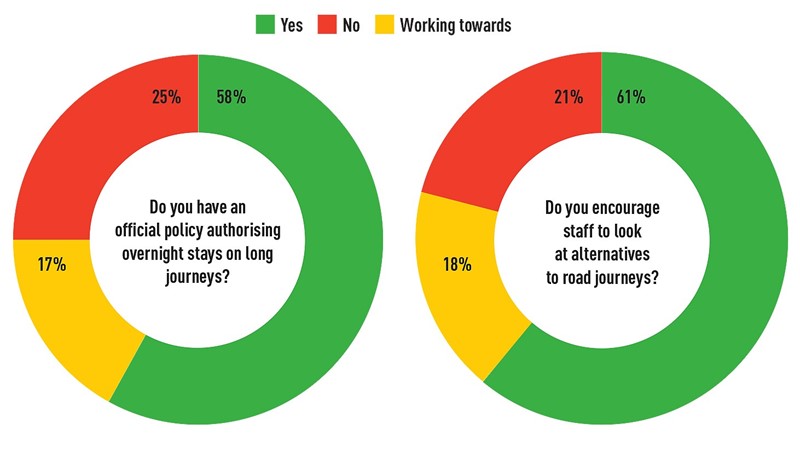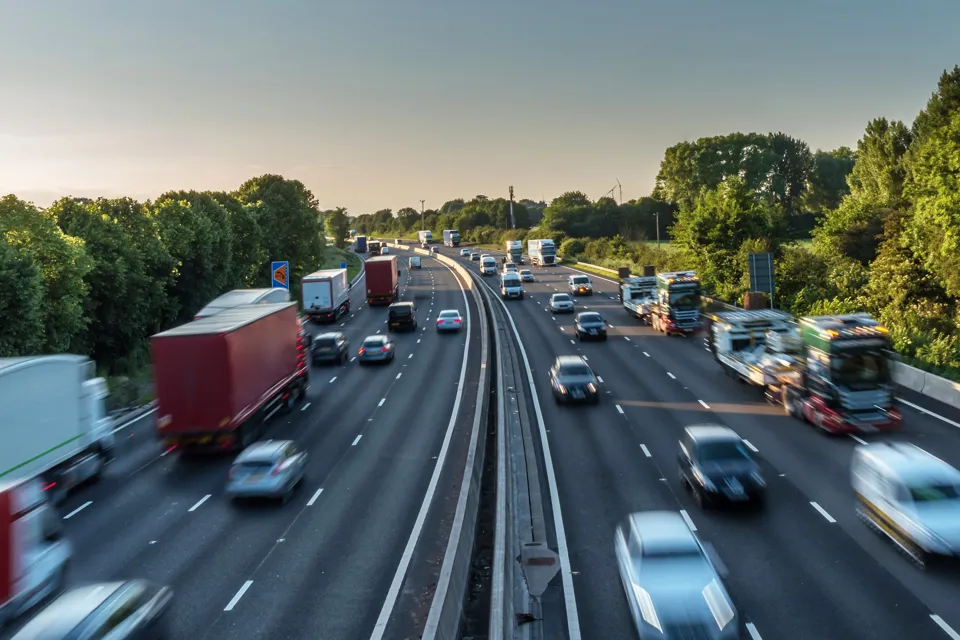Journey management is becoming increasingly important as the business world moves towards managing safe, sustainable mobility rather than simply vehicles and drivers.
Employers are concerned not just with improving safety and compliance through better fleet risk management, but with the productivity and efficiency improvements that can come from having people on the road for less time, together with the environmental and sustainability benefits directly linked to this.
The first question employers are asking, therefore, is whether the journey is actually necessary and whether other solutions such as public transport or video conferencing may be better options – not just in terms of direct benefits as far as risk, productivity and sustainability are concerned, but as part of an overall travel policy that fits with company values.
Increasingly, businesses are trying to demonstrate their environmental credentials to differentiate themselves from the competition.
The approach, therefore, is flipped with the default starting point being that communication is done via tele- or video-conferencing and, if that is not possible, the next option is to take public transport, then a company vehicle and then a hire car.
The company may not even countenance a grey fleet option due to the added admin involved in controlling the risk, not to mention the likely extra emissions as grey fleet cars tend to be much older.
Of those completing the Driving for Better Business (DfBB) online risk assessment, 61% said they now actively encourage staff to look at alternative methods of transport or telephone/video-conferencing to improve productivity.
A further 18% said they were working towards the same goal leaving just one-in-five employers seemingly content to let their drivers get on with things regardless of whether it had a negative affect on the contribution those people make to the business.

 Businesses falling short of standards
Businesses falling short of standards
Overall, users scored an average across the Journey Management section of 58% when they should be aiming to hit 70-75%. Therefore, a lot of businesses are not reaching the level of journey risk management they really should be achieving.
Some of these risks are becoming much more critical as, with a third of road collisions involving someone who is driving for work at the time, the police are increasingly realising that it isn’t always just the driver at fault.
The driver is ultimately responsible for his or her behaviour on the road, as well as the roadworthiness of the vehicle. However, we are hearing more stories from lawyers and members of the judiciary about serious incidents where accepted company practice, poor management and work procedures can be a significant contributory factor – and directors are being called to account.
These contributing factors are often related to journey management. So, employers need to address these challenges urgently.
One of the biggest challenges is ensuring drivers have enough time to complete their work schedule safely without being effectively required to speed or take other unnecessary risks.
The DfBB risk assessment asks two relevant questions: “Are you satisfied that work schedules are realistic and don’t give drivers a reason to take risks or exceed speed limits?” And, secondly: “Do you apply adequate limits on the length of drivers’ working days including both work time and driving/commuting time?”
In both cases, 60% of businesses answer yes, they do ensure this is the case, 20% are working towards it and 20% aren’t.
One of the key things here is for business leaders and driver managers to be sure their policies are being followed as there can sometimes be a disconnect between what they think is happening and what is actually happening.
DfBB carried out a survey of more than 1,000 business drivers which found that one-in-four had been involved in a driving for work incident while trying to keep up with a busy schedule.
This was specifically a bigger problem with younger drivers where one-in-three (aged 18-34) said they had been involved in an incident, perhaps because they felt less able to challenge the managers they reported to, while just one in 11 of those aged more than 55 said they been involved in a similar incident.
There was also a noticeable spike for those drivers operating in Greater London where almost half said they had been involved in an incident specifically as a result of their busy work schedule – almost twice that of any other region in the UK.
No time to rest
Not giving drivers enough time to complete their rounds and incorporate sufficient break time for rest and refreshment can have a massively detrimental effect on driver wellbeing and safety.
One driver was recently stopped in the south-west while eating his lunch at the wheel, and therefore not being in full control. The subsequent police check also highlighted a number of safety issues relating to the maintenance of his vehicle.
Multi-drop delivery drivers also regularly complain of schedules that are so tight they don’t even have time to go the toilet, which means they don’t drink enough leading to dehydration and increased fatigue which then impairs concentration and the ability to make sound decisions.
For those making journeys by car, and where an overnight stay might be possible, employers should really be looking to include a specific clause in their driving for work policies so drivers know where they stand. A common solution is to specify a maximum journey distance or travel time, beyond which the company automatically authorises an overnight stay to relieve some of the pressure. More than half (58%) of companies on our risk assessment have such a provision written into their policies. However, one-in-four don’t.
Of course, drivers can still flout this if they’re keen to get home, so managers need to monitor the situation to ensure drivers aren’t regularly on the road for a full day followed by an unreasonable drive home after their last stop.
One of the obvious ways some pressure can be lifted from busy work schedules is the provision of sat-nav systems for drivers. These are proven to have many benefits including getting drivers to their appointments quicker and with fewer unexpected delays. They also help cut the mileage travelled which in turn reduces both fuel costs and emissions for the business and improves wellbeing for the drivers who suffer less stress.
Half of the companies on our risk assessment ensure their drivers have access to sat-nav – either as standard factory-fitted equipment in their vehicle or with the addition of a portable unit – but a third still don’t.
While an increasing number of vehicles now come with sat-nav, employers would do well to review the benefits listed above and then review their vehicle acquisition policies to ensure sat-nav is fitted to as many vehicles as possible.
The last risk we’re going to look at is the one that employers scored lowest on by a significant margin and that is the journey route itself. Probably more pertinent to van fleets than cars, with their regular delivery routes and client servicing schedules, risk assessing the journey route is important when the same journey is carried out on a regular basis.
Re-routing to safer roads
Only one in five fleets assess their regular journey routes for known high-risk locations such as schools or incident blackspots. The risk to the business could be significantly reduced by re-routing some of these journeys onto safer roads. If your van fleet is fitted with telematics, you may be able to create a heat-map that shows where your fleet are most likely to speed or have incidents and then use this data to either coach drivers or re-route to avoid some of these locations.
Assessing journey routes for necessity and utilisation can also be a valuable activity and result in significant reductions in both risk and operating costs. It may sound obvious, yet less than a third of companies say they do this. Even adding this figure to those actively considering it still only amounts to less than half (49%).
Duplicate journeys
Any company that grows either organically or through acquisition can quickly find it is duplicating all or part of particular journeys with multiple vehicles. Fleets can also find they are operating more routes than necessary with under-utilised vehicles which might require replanning of the routes or the type/size of vehicles being used.
Lower fuel usage is just one benefit from ‘right-sizing’. According to the Department for Transport, the average laden factor of a van is only 38%, and AECOM research showed that 39% of vans carry less than a quarter of their maximum payload.
DfBB is all about raising awareness of the business benefits that come from improved management of work-related road risk. Journey management is just as important as driver competence and vehicle roadworthiness and can have a dramatic impact on operational efficiency.
Construction giant Amey, a DfBB Champion, focused on this issue to gain a greater understanding of how its people were using their vehicles. The results vindicated the approach:
*Fuel efficiency improved by 4% over 12 months (Amey’s national fuel bill is £1.6million per month).
*CO2 emissions down by 6% over 12 months.
*Fleet utilisation improved by a whopping 30% over 18 months.
Results like that make a big difference to any business.


















Login to comment
Comments
No comments have been made yet.